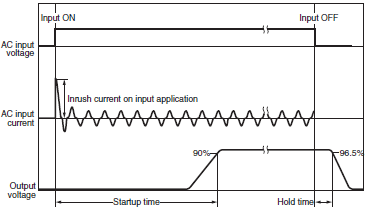| Power rating | 240W | 480W | 960W | ||
|---|---|---|---|---|---|
| Output voltage | 24V | 24V | 24V | ||
| Efficiency *1 | Three-phase 400 VAC input | 93% typ. | 94% typ. | 95% typ. | |
| Two-phase 400 VAC input | 93% typ. | 94% typ. | 95% typ. | ||
| Input
conditions |
Input voltage range *2 | Three-phase/two-phase 320 to 576 VAC, 450 to 810
VDC |
|||
| Frequency *2 | 50/60 Hz (47 to 63 Hz) | ||||
| Input current *1 | Three-phase 400 VAC input | 0.41 A typ. | 0.79 A typ. | 1.6 A typ. | |
| Two-phase 400 VAC input | 0.75 A typ. | 1.5 A typ. | 3.0 A typ. | ||
| Power factor *1 | Three-phase 400 VAC input | 0.9 min. | |||
| Leakage current
*3 |
Three-phase 400 VAC input | 3.5 mA max. | |||
| Inrush current *4 | Three-phase 400 VAC input | 1.9 A typ. | 3.3 A typ. | 10.6 A typ. | |
| Output
character- istics |
Rated output current | 10 A | 20 A | 40 A | |
| Power Boost Function | 15 A | 30 A | 60 A | ||
| Voltage adjustment range *5 | 24 to 29.5 V (with V.ADJ) | 24 to 28 V
(with V.ADJ) |
|||
| Ripple noise
voltage *6 |
Three-phase
380 to 480 VAC input |
100 mV p-p max.
at 20 MHz of bandwidth |
80 mV p-p max.
at 20 MHz of bandwidth |
50 mV p-p max.
at 20 MHz of bandwidth |
|
| Input variation influence *7 | 0.5% max. | ||||
| Load variation influence *8 | 1.5% max. | ||||
| Temperature
variation influence |
200 to 240 VAC input | 0.05%/°C max. | |||
| Startup time *9 | Three-phase 400 VAC input | 1,000 ms max. | |||
| Output hold time
*9 |
Three-phase 400 VAC input | 30 ms typ. | 25 ms typ. | 20 ms typ. | |
| Additional
functions |
Overload protection | Yes, automatic reset, intermittent operation type Refer
to Overload Protection on below. |
|||
| Overvoltage protection | Yes, 130% or higher of rated output voltage, power
shut off (shut off the input voltage and turn on the input again), Refer to Overvoltage Protection on below. |
||||
| Series operation | Yes (For up to two Power Supplies; external diodes
required.) |
||||
| Parallel operation | Yes (For up to two Power Supplies), Refer to Parallel
Operation on Data Sheet. |
||||
| INPUT OK Indicator | Yes (LED: Green) | ||||
| DC OK Indicator | Yes (LED: Green) | ||||
| Iout > 100% Indicator | Yes (LED: Yellow) | ||||
| DC OK Signal Output | Yes (MOS FET relay output 30 VDC max., 50 mA max.) | ||||
| Iout > 100% signal output | Yes (MOS FET relay output 30 VDC max., 50 mA max.) | ||||
| Insulation | Withstand voltage | 3.0 kVAC for 1 min. (between all input terminals and
all output terminals, signal output terminals), cutoff current 20 mA |
|||
| 2.5 kVAC for 1 min. (between all input terminals and
PE terminals), cutoff current 30 mA |
|||||
| 1.0 kVAC for 1 min. (between all output terminals,
signal output terminals and PE terminals), cutoff current 25 mA |
|||||
| 0.5 kVAC for 1 min. (between all output terminals and
all signal output terminals), cutoff current 10 mA |
|||||
| Insulation resistance | 100 MΩ min. (between all output terminals, signal
output terminals and all input terminals / PE terminals) at 500 VDC |
||||
| Environ-
ment |
Ambient operating temperature *10 | -40 to 70°C (Derating is required according to the
temperature. Refer to Engineering Data on Data Sheet.) (with no condensation or icing) |
|||
| Storage temperature | -40 to 85°C (with no condensation or icing) | ||||
| Ambient operating humidity | 95% max. (Storage humidity: 95% max.) | ||||
| Vibration resistance *11 | 10 to 55 Hz, maximum 5 G, 0.42 mm single amplitude
for 2 h each in X, Y, and Z directions |
||||
| Shock resistance *11 | 294 m/s2, 3 times each in ±X, ±Y, ±Z directions | ||||
| Reliability | MTBF *12 | 170,000 hrs typ. | 160,000 hrs typ. | 140,000 hrs typ. | |
| Expected life *13 | 10 years min. | ||||
| Construc-
tion |
Weight | 890 g max. | 1,200 g max. | 1,800 g max. | |
| Cooling fan | No | ||||
| Degree of protection | IP20 by EN/IEC 60529 | ||||




